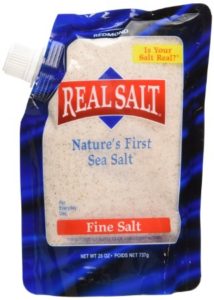To Salt or Not to Salt
We’ve talked about salt a lot in the past in my migraine support group and whether it’s beneficial or not and how it helps migraines. It’s an important topic for everyone, not just migraineurs because for good health, we all need to balance our minerals/electrolytes.
Generally speaking, problems arise when the wrong salts are consumed not by simply having salt in your diet. If a person has a health condition like congestive heart failure, he/she does need to be more cautious and perhaps avoid excess salt, but interestingly true high blood pressure can sometimes actually be caused by regular intake of anti-inflammatories and/or other drugs and sugar intake as well. See this blog post for more info; http://www.realsalt.com/sea-salt/is-high-blood-pressure-linked-to-salt-or-sugar/
Here’s a comment from a recent post in a well-informed magnesium group I’m in: “your body is largely water which conducts electric-like currents to metabolize nutrients. Minerals improve currents because they contain ‘ELECTROlytes’. Sodium and magnesium are only 2 of many electrolytes needed to ‘fire’ things off in the right directions. conclusion: salt is not bad for you if it has minerals. Being on this page teaches those with ailments that the ‘advice’ from health care professionals who tell people to use less salt may be not be best for them. Try celtic or Himalayan salt and write down your ailments to see which go away or improve.”
Now, there have been findings that some sea salt or Himalayan salt (from other countries) is processed with outside ingredients changing its potential benefits and adversely affecting iron levels. There seems to be a large agreement that “Real Salt” by Redmond (see picture above) is a great brand to use and trustworthy. If you can’t find it in the stores by you, you can order it from Redmond or from Amazon. It’s mined from the ocean floor deep beneath Utah so it doesn’t travel as far to your kitchen (if you’re in the US), which is generally a good thing for anything we consume.http://www.amazon.com/Real-Salt-Sea-Pouch-26-Ounce/dp/B000BD0SDU/ref=sr_1_1_a_it?ie=UTF8&qid=1464010875&sr=8-1&keywords=real+salt
It is true that sea salt has not been enriched with iodine. Iodine doesn’t occur naturally in any salt and the federal government mandated it at some point so that’s why it’s in table salt. This is part of the problem with table salt; it’s been processed to add iodine, and maybe other things, and remove some of the minerals in that process. If you are concerned with your iodine intake, you can buy iodine tablets or drops and add them to your diet here and there. You can also be assured that if you eat at restaurants you are almost certainly getting iodine because most of them will use table salt to cook with and provide to guests on the tables. Also, if your thyroid tests are fine (and not just TSH) then you don’t likely need to add more iodine to your diet. Keep in mind that thyroid dysfunction can be related to adrenal fatigue as well and sea salt consumption can help balance that by balancing mineral intake. But that’s a whole other topic!
Real Salt may cost a bit more up front than some others, but it will last a long time because it’s granulated, and you use less than you’d think.Yes you can find cheaper products at many places, like Walmart and in the check out aisle at discount department store, but the problem is you will have no idea where the salt actually came from and you may be wasting your money. I carry it in a camping salt shaker in my purse to use everywhere I go. I even put some under my tongue some times when I’m beginning to get a migraine, and it can actually halt it. I also have heard of people consuming a little less than a 1/4 teaspoon during an anxiety attack and very quickly feeling better.


